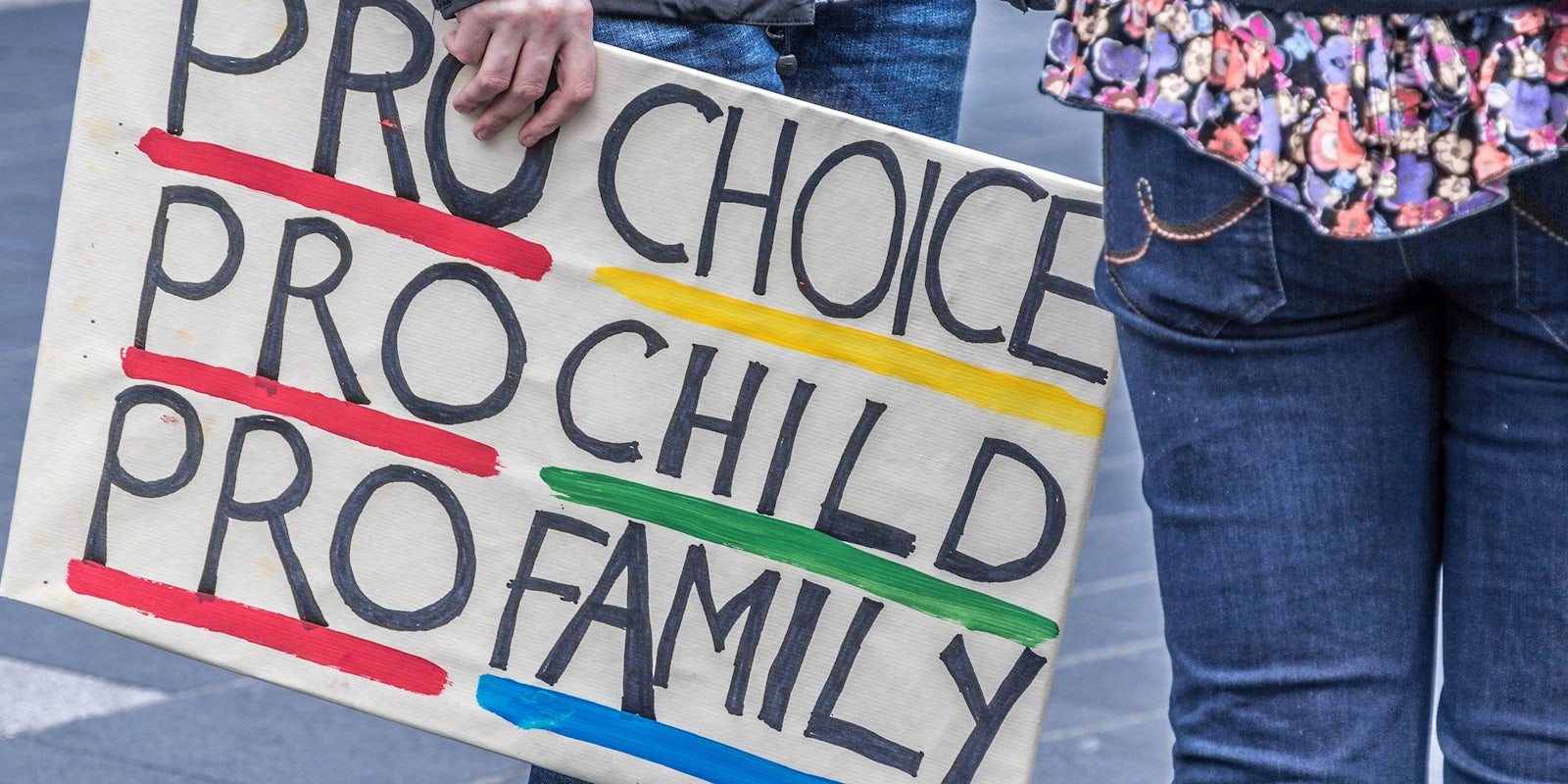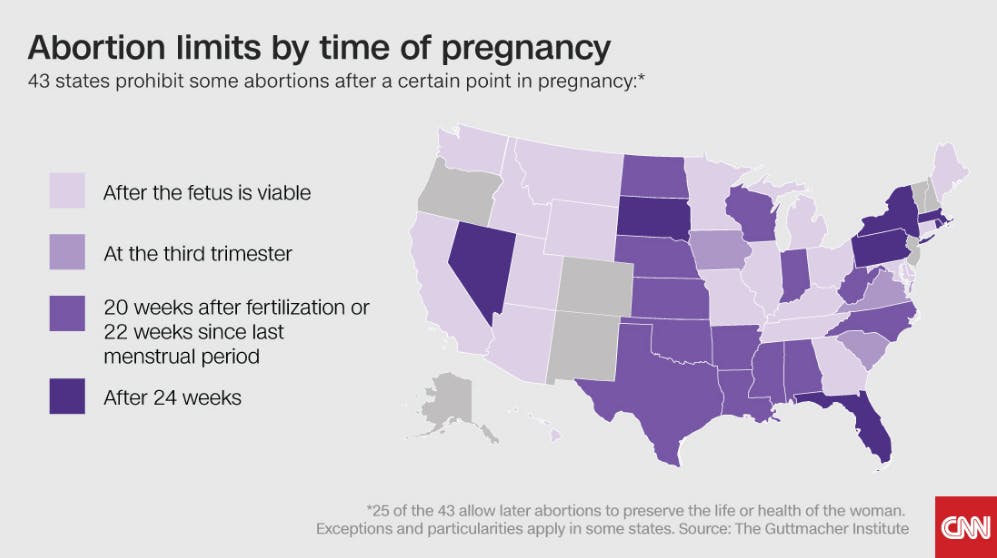Since the monumental 1973 Supreme Court case Roe v. Wade, abortion has been legal in the United States. However, over the past 43 years, state and federal legislators have passed numerous restrictions to inhibit women from access to safe, affordable, and legal abortions.
One of the most controversial restrictions is the Hyde Amendment, which is a bill rider that’s re-upped every year to prevent federal funds from being used to pay for abortion. The amendment only allows Medicaid to cover abortions for victims of rape or incest, or for women whose lives are in danger because of their pregnancy. Many argue that such restrictions target the poor and working class, since they often can’t afford the procedure, and by the time they may be able to gather the money, they’ve passed the window for a legal abortion.
Currently, 43 states prohibit abortions after a certain number of weeks in a woman’s pregnancy (usually within 22 to 26). Under George W. Bush’s Federal Abortion Ban, upheld by the Supreme Court in 2007, certain abortions done in the second trimester have also been criminalized. Other states have passed much stricter laws—for years, North Dakota prohibited abortions after six weeks—with Oklahoma and Indiana having tried to make abortion completely illegal, despite such laws being totally unconstitutional.
Another common form of state-enacted restrictions include “TRAP” (Targeted Regulation of Abortion Providers) laws, which impose stricter requirements of doctors and facilities that provide abortions, making them harder to stay open and more difficult for women to access. Since 2011, more than 160 abortion providers have shut down across the country as a result of these laws.
However, in June, the Supreme Court overturned one of the most restrictive Trap laws in the country, Texas House Bill 2. Before HB2, Texas had over 40 abortion clinics; today there are 10. SCOTUS determined that two provisions of the Texas law—requiring abortion providers to have hospital-admitting privileges, and requiring abortion providers to have facilities comparable to surgical centers—placed an “undue burden” on women seeking abortions.
But the impact of TRAP laws cannot be erased. With so many facilities closed, women have been forced to travel across the nation to acquire the health care they need—and yet many can’t afford the time off from work or the cost of getting on an airplane to get a legal abortion. Not to mention, in many states, there are other hurdles women must jump through before the procedure can even take place: wait times, videos, ultrasounds, even preparing burials for their unborn fetus.
“Sometimes the barriers put in place are too great for women to overcome,” said Vicki Saporta, president and CEO of the National Abortion Federation, in a statement to the Daily Dot. “Your income and where you live shouldn’t determine whether or not you have access to quality abortion care.”
President-elect Donald Trump, who will at least nominate one Supreme Court justice in his tenure, has threatened to overturn Roe vs. Wade and put a national 20-week ban on abortion access. Trump is also in favor of validating the Hyde Amendment, which is the greatest barrier for women’s reproductive rights.
The discussion of abortion and a woman’s right to choose has been a clear divide between the Republican and the Democratic parties for decades. Arguments against abortion declare it to be murder or immoral, but there are legalities and facts surrounding abortion and women’s rights that many critics overlook. Here are a few:
1) The U.S. Supreme Court declared abortion a nationwide fundamental right.
Passed in 1973, Roe v. Wade is the rule of the land. It declares a woman is capable of making her own medical decisions regarding her own body, without the intrusion of the government. It falls within the 14 Amendment under the right to privacy.
2) Personhood begins once a fetus is able to survive outside of the womb; similarly, a fetus does not feel pain.
A human is considered viable when it is able to withstand life outside of the fetus. Roe v. Wade states that “the word ‘person,’ as used in the 14th Amendment, does not include the unborn.”
According to the New York Times, a panel of neuroscientists from Britain’s Royal College of Obstetricians and Gynaecologists, say the cortex is necessary for pain perception, which is not developed until the 26th week of pregnancy after the majority of abortions are completed. This was then backed by American College of Obstetricians and Gynecologists in 2012, stating there is no legit scientific evidence of a fetus experiencing pain.
Abortions late into a pregnancy are extremely rare and are restricted by certain state laws.
3) There are many reasons a woman may not want to bring a child to term—but finances often play a part.
A study in 2005 by Guttmacher Institute surveyed women on the reasons why they had an abortion: 73 percent of respondents said they could not afford to have the baby, and 38 percent said a child would interfere with their education and career goals. An estimated 42 percent of women who have abortions live below the federal poverty level and are not able to financially provide for a child.
Some women choose to have abortions due to abnormalities that they will not be able to medically afford throughout the child’s life, or the abnormalities are so severe that they will either die before or after birth and put the mother’s life at risk.
Deborah A. Driscoll, chief of the obstetrics department at the University of Pennsylvania, told the New York Times that many couples are choosing to not bring a child with abnormalities to term due to their unintentional shortcomings. These women do not have “the resources, the emotional stamina, don’t have family support.”
4) Access to legal abortions by professionally trained surgeons reduces maternal injury and death.
According to the World Health Organization, legal abortions are one of the safest procedures in contemporary medical practice, with case-fatality rates less than one death per 100,000 legal procedures.
However, with restrictions on abortion access resulting in practice closures nationwide, women been have forced to seek other means of access if they are not able to receive the help they need. An estimated 68,000 women die every year around the world from unsafe abortion procedures, and millions more are injured. If the procedure was accessible for women, regardless of income, the number of fatalities would be next to none.
5) Reproductive choice empowers women, providing them the right to govern over their bodies.
Then-Supreme Court Justice Sandra Day O’Connor wrote in the 1992 decision Planned Parenthood v. Casey that “the ability of women to participate equally in the economic and social life of the nation has been facilitated by their ability to control their reproductive lives.”
Restricting the access to a safe and legal abortion or forcing a woman to carry a fetus to full-term against her will is a violation of the individual rights that this country prides itself upon.
“Having access to safe and legal abortion care allows women to fully participate in society,” Saporta of the National Abortion Federation says. “Society benefits when women fully participate and it’s a matter of fairness, equality, and human rights.”



